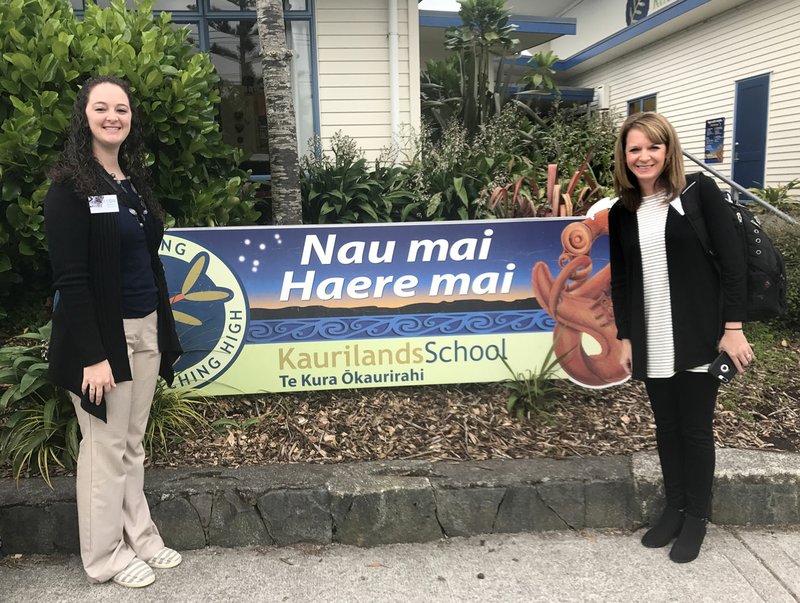Two Siloam Springs educators traveled half-way around the world to New Zealand in October to see the country's innovative teaching practices first hand. Now they are looking for ways to implement those ideas at home.
Tamara Lane, Southside Elementary School assistant principal, and Rebecca Evans, Southside Elementary School teacher, spent eight days in the country with a group of teachers and administrators from seven districts in Northwest Arkansas. The trip was part of a two-year-long project made possible by a partnership between the University of Arkansas Office of Innovation and the Walton Family Foundation.
"The trip to New Zealand international experience was just the beginning of the project," Lane said.
Now that they are home, Lane and Evans are working with Principal Dan Siemens to determine and implement at least three practices that will be effective for Southside Elementary School.
The Office of Innovation supports educators at public and private schools and looks for ways to incorporate innovative practices and out-of-the-box thinking, Lane said. Northwest Arkansas already has a lot of personalized and blended learning going on at the secondary level and the project is focused on bringing those practices to the elementary and middle school levels, she said.
Educators toured schools in New Zealand because the country has been successful in implementing innovative practices with a population that is similar in size and demographics to Arkansas. New Zealand has a diverse population, both in terms of the number of languages spoken and the range of socioeconomic status, according to Lane and Evans.
While in New Zealand, the group of Arkansas educators visited seven schools. They also got a chance to do a bit of sightseeing, visiting the country's black sand beaches, and even going zip-lining over the jungle.
"Each school was unique, they didn't all look the same," Lane said. "They were very much reflective of their communities and we saw a wide range, just like we have in Arkansas, of high SES (socioeconomic status) to low SES. It was neat to see different environments and how they mirror what we have in Siloam Springs and also the differences.
New Zealand has three official languages -- English, sign language and the native language Maori, Lane said. The country also has a large population of students from Asia and the Philippines who speak English as a second language.
"They are very similar to us with the ESL population and the SES population, so it was nice to know the school districts are having success with the same type of children that we have here," Evans said.
Some of the most common innovative practices in New Zealand include mixed-age classes and allowing students to learn at their own level and pace, Evans said. For example, if a student mastered everything in third grade they could move on to fourth grade without having to wait for the next year.
Schools have a family feel, with older students helping younger students, and teachers collaborating to help all students, Evans said.
Other innovative practices include allowing students to learn through "passion projects." Students may be assigned certain academic tasks, but they center those tasks around a topic of their interest, Evans and Lane said. For example, a student who was passionate about dinosaurs could write an essay on the topic and chart how they became extinct, or a child who was passionate about dance or basketball could explore the math that is related to those subjects, Evans said.
Schools call both teachers and students learners, and there is a lot of focus on ownership and teaching children how to learn, Lane said.
"In general, engagement was high," Evans said. "We didn't see a lot of kids not working on what they were supposed to be working on."
The population in Auckland has grown very quickly in a short amount of time, so the area has many new school buildings with flexible seating, Evans said. Many of the newer buildings had large open areas instead of individualized classrooms where children might work independently or in a small group. Three certified teachers may circulate through a group of 90 children, each helping them with what they need help with.
"They just teach them how to be good learners," Evans said. "They are taught from kindergarten how to make good choices."
Schools in New Zealand are not separated by districts, Lane said. Each school reports directly to the education ministry. The ministry is responsible for hiring a principal, who appoints a board of local community members and parents to make decisions for the school. Teachers are paid on the same pay scale, regardless of the school they work for.
Since all schools have the same pay scale, teachers can pick the school that fits best with their values.
"It's not about 'My family's in need of additional funds so I can travel 30 minutes and make a different level pay," Lane said.
Overall, the focus on New Zealand's schools was making sure students are thriving physically, emotionally and academically, Lane said. The schools focus on educational outcomes, and what students need to know when they graduate and go to work in the real world.
"It really was teaching the whole person how to be the best you can be," Evans said. "We didn't know what to expect, but we walked away with the idea that we were on the right track."
General News on 12/13/2017
